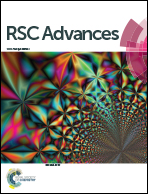Polyurea dendrimer for efficient cytosolic siRNA delivery†
Abstract
The design of small interfering RNA (siRNA) delivery materials showing efficacy in vivo is at the forefront of nanotherapeutics research. Polyurea (PURE-type) dendrimers are ‘smart’ biocompatible 3D polymers that unveil a dynamic and elegant back-folding mechanism involving hydrogen bonding between primary amines at the surface and tertiary amines and ureas at the core. Similarly, to a biological proton pump, they are able to automatically and reversibly transform their conformation in response to pH stimulus. Here, we show that PURE-G4 is a useful gene silencing platform showing no cellular toxicity. As a proof of concept we investigated the PURE-G4-siRNA dendriplex, which was shown to be an attractive platform with high transfection efficacy. The simplicity associated with the complexation of siRNA with polyurea dendrimers makes them a powerful tool for efficient cytosolic siRNA delivery.



 Please wait while we load your content...
Please wait while we load your content...